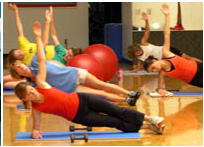 I love to know the most efficient ways to get things done. I organize my kitchen so that my cereal bowls, spoons, cereal and coffee are right by my fridge where I grab my milk and blueberries every morning. I keep a set of toiletries, change of clothes and a hairdryer in my locker at work so that I do not have to remember to pack them on days I work out at the gym. My husband and I live less than 1 mile from his work so we only have to rely on one fuel efficient car. I've talked about the most efficient abs exercises in a previous E-mail. So, today I am going to talk about some extremely efficient foods that top my list of favorites.
I love to know the most efficient ways to get things done. I organize my kitchen so that my cereal bowls, spoons, cereal and coffee are right by my fridge where I grab my milk and blueberries every morning. I keep a set of toiletries, change of clothes and a hairdryer in my locker at work so that I do not have to remember to pack them on days I work out at the gym. My husband and I live less than 1 mile from his work so we only have to rely on one fuel efficient car. I've talked about the most efficient abs exercises in a previous E-mail. So, today I am going to talk about some extremely efficient foods that top my list of favorites.I am a HUGE cereal fan so I couldn't have been happier when I saw some of the healthiest cereals listed in this month's issue of Women's Health:
If you like tasty flakes mixed with nutty clusters, try Kashi Heart to Heart Oat Flakes with Blueberry Clusters. I am a big fan of Kashi cereals because they are packed with nutrients. I've kept this cereal stocked in my cupboard for a long time. YUM!
If you like crunchy honey oats try Health Valley Real Oat Bran Almond Crunch. This cereal has 5 grams of fiber and 6 grams of protein per serving! Natural vanilla and amaretto malt...I'm going to try this cereal next.
If you like to keep healthy snack bars around your office rather than choosing unhealthy snack machine options try Balance Bar 100 Calorie Snack Bars. These delicious treats also have 5 grams of fiber and 6 grams of protein. I'm also a big fan of Dannon Light and Fit Yogurt as a snack. The 6 oz. servings only have 60 calories and 5 grams of protein!
These foods that heal are from this month's issue of Yogalife:
Cranberries are shown to fight off gastrointestinal and urinary infections as well as helping to keep your arteries clean. They may even help prevent cavities. I love to toss dried cranberries into my salad or cereal.
Artichokes are one of my favorite pizza toppings...made from whole wheat flat bread of course. Artichokes provide tons of vitamin C, fiber and minerals such as copper and magnesium and are one of the most powerful anti-oxidants. These are also great with olives in a salad.
Quinoa...que what? This healthy grain, pronounced Keen-wa, is packed with protein and fiber. In fact, many compare its nutritional value to that of milk. Do you want to take advantage of this efficient grain but not sure what to do with it? Check out this article for recipe ideas: http://healthycooking.suite101.com/article.cfm/quinoa_recipes
Apples Some things never change, including the overwhelming nutritious value of an apple. The antioxidants in apples help clear your body of bad cholesterol (LDL) and may fight carcinogens. The shiny apples I always keep in my fruit bowl are not just for decoration!
Try some of these health packed food choices next time you visit the grocery store. I’m off to try to efficiently finish my homework before class :) Have a great day everyone!



